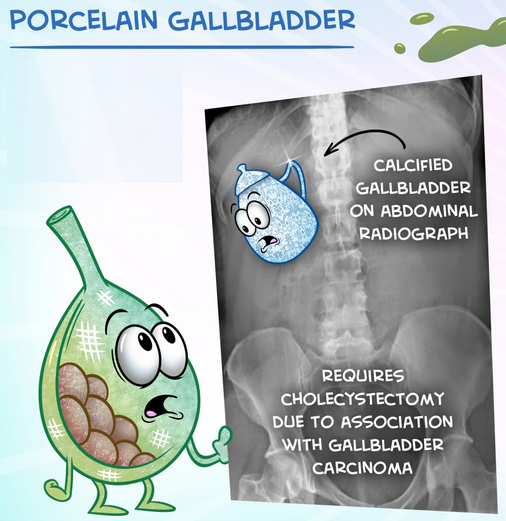In level 1 of the Diagnostic Medical Sonography Program, we learned about normal anatomy. Level 2 and 3 is all about pathology. This post is about which pathologies are more common in women and which are more common in men.
Women
 The Gallbladder
The Gallbladder
Women are 3x more likely than men to get gallstones. They are also 2x more likely to get GB cancer, which is a rare cancer.
Women are more likely to get a porcelain gallbladder, which is the calcification of the gallbladder. They are also more likely to get cholecystitis, an inflamed gallbladder.
The Urinary System
Angiomyolipoma is 4x more likely in women, which is a benign growth in the kidney. Lupus Nephritis is seen more in women, which is the inflammation of kidneys from Lupus. Selena Gomez had lupus nephritis and had a kidney transplant.
Adrenal adenoma, is a noncancerous growth in the adrenal glands that are above the kidneys.
Because Women have a short urethra, they have higher chance of contracting a Urinary Tract infection. It is a shorter distance for bacteria to travel to the bladder. A female urethra is 4cm long and the male urethra is 20cm long.
The Liver
Women get more cysts and benign masses in their liver than men do. Hemangioma is a collection of blood vessels and is an abnormal growth. Focal Nodular Hyperplasia and Hepatic Adenoma both caused by birth control pills, are two other mass found in the liver. Hepatic Adenoma are 9x more likely in women.
Others
 Serous or mucinous cyst in the pancreas.
Serous or mucinous cyst in the pancreas.
Both hyperthyroidism and hypothyroidism are more likely diagnosed in women. Women are 2x more likely to have a thyroid malignancy. Oprah and Hilary Clinton both have thyroid problems.
Sjogren syndrome is an immune system disorder that causes dry eyes and a dry mouth.
Femoral Hernia which is most likely due to child birth.
Men
The Urinary Tract
 Renal cell carcinoma, a cancerous tumor in kidneys. Men are 4x more likely to get Transitional cell carcinoma which is a cancer of the bladder. Renal oncocytoma is a benign kidney growth.
Renal cell carcinoma, a cancerous tumor in kidneys. Men are 4x more likely to get Transitional cell carcinoma which is a cancer of the bladder. Renal oncocytoma is a benign kidney growth.
Urolithiasis, stones in the urinary tract.
Bladder outlet obstruction, BOO for short, usually caused by an enlarged prostate, causing men to have difficulty voiding.
Men over 50 are more likely to get Retroperitoneal fibrosis, fibrous tissue growth in the area where the kidneys, aorta, renal tract and other structures are found. It is an inflammatory disease.
The Liver
Hemochromatosis is 10x more likely in men, which is the abnormal absorption and storage of iron in the body.
Hepatocellular carcinoma, which is a primary cancer of the liver, is 5x more common in men.
The GI Tract
Intussusception, is where part of the intestine slides into an adjacent part of the intestine.
For some reason boys are more likely to get Appendicitis. Men are more likely to get sclerosis cholangitis which is scars in your bile duct.
 Men are 3x more likely to get chronic pancreatitis. Because of the chronic pancreatitis they are also more prone to pancreatic pseudocyst, which is a fluid filled area in the abdomen caused by leaked pancreatic enzymes. Men are also more likely to get pancreatic cancer. Patrick Swayze and Steve Jobs had pancreatic cancer.
Men are 3x more likely to get chronic pancreatitis. Because of the chronic pancreatitis they are also more prone to pancreatic pseudocyst, which is a fluid filled area in the abdomen caused by leaked pancreatic enzymes. Men are also more likely to get pancreatic cancer. Patrick Swayze and Steve Jobs had pancreatic cancer.
Others
Acute Myeloid Leukemia, a blood cancer are more common in males.
Men are 5x more likely to get Aortic aneurysm than women. Albert Einstein and John Ritter had Ao Aneurysms.
Inguinal Hernia could be do to congenital reasons or from weakened abdominal muscles with age. The Rock had a hernia.
Equal prevalence
Infertility, 40% due to male factor, 40% due to female factor, and 20% unknown reasons.
Featured Image: man vs. woman
Content Cred: Abdominal & Superficial Structures Sonography 2 and Abdominal & Superficial Structures Sonography 3 course notes.
Image Cred: Porcelain GB, thyroid, bladder, pancreas

 The Gallbladder
The Gallbladder